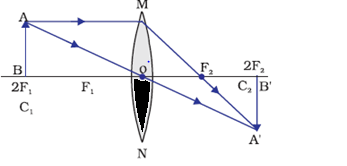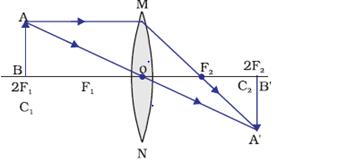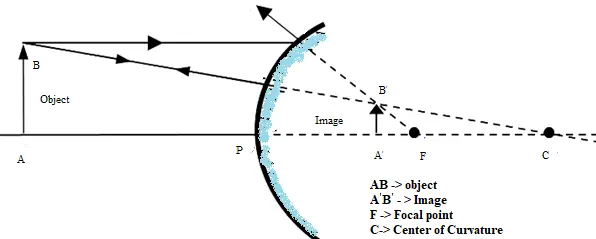

Welcome to this page on Numericals on Light for Class 10 Science chapter 10. These questions will help you improve your ranks with the great collection of Numericals on Light Class 10 of 3 marks questions. These light reflection and refraction class 10 questions and answers are from various topics and formulas like
Answer 1. This occurs due to the, phenomenon of refraction of light. Here, the ray of light from the coin travels from a denser medium to a rarer medium . In this process it bends away from the normal . The point from which the refracted rays appear to come gives the apparent position of the coin. As the rays appear to come from a point above the coin, so, the coin seems to be raised.
Answer 2.
Given object size = 5 cm
object distance from lens $u = -30$ cm
focal length $f = 20$ cm,
We have to find $v = ?$
Using the lens formula $\frac{1}{f} = \frac{1}{v}-\frac{1}{u}$
We have,
$ \frac{1}{v} = \frac{1}{u} + \frac{1}{f} = \frac{1}{-30} + \frac{1}{20} = \frac{ -2+3 }{ 60 } = \frac{1}{60}$
or,
$\frac{1}{v} = \frac{1}{60}$
Thus
$v = 60cm$ . This is part (i) of the question
magnification
$\frac{v}{u} = \frac{60}{-30} = -2 $
$Magnification \quad = \quad \frac{Image \quad size}{Object \quad size}$
$\frac{h_i }{h_o}=-2 $
$\frac{h_i}{5}=-2$
$h_{i}= -2 \times 5 = -10 \quad cm$
The image is real inverted and magnified.
Answer 3.
(1) New Cartesian sign conventions for measuring the various distances in the ray diagrams (reflection by spherical mirrors)
1. All the distances in a ray diagram are measured from the pole of the spherical mirror.
2. The distances measured in the direction of incident light are taken as positive.
3. The distances measured in the direction opposite to the direction of incident light are taken as negative.
4. The heights measured upwards and perpendiculars to the principal axis of the mirror are taken as positive.
5. The heights measured downwards and perpendiculars to the principal axis of the mirror are taken as negative.
Answer 3.
(2) Visit page https://physicscatalyst.com/Class10/light-reflection-and-refraction.php#spherical-mirrors
Answer 4
The following activity can be used to determine the principal focus and approximate focal length of a concave mirror.
(1) Place the mirror vertically on a table.
(2) Place an object (a pencil) in front of the mirror and move it towards and away from the mirror.
(3) Find the approximate spot where the reflection of the object changes from upright to upside down. This point is the focus of the mirror. Measure the distance between this point and the mirror. This length is the focal length of the mirror.
Answer 5
Given that $h_1 = 4.5 \quad cm,\quad u = - 12 cm, \quad f = 15 cm$
We have to find $ v = ?$
using the equation of the mirror formula $\frac{1}{f} = \frac{1}{v}+\frac{1}{u}$
we have,
$\frac{1}{15} = \frac{1}{v}+\frac{1}{-12}$
$\frac{1}{15}+\frac{1}{12}=\frac{1}{v}$
By solving we get v= +6.6 cm.
Now, magnification
$m= \frac{h_2}{h_1}=-\frac{v}{u}$
Thus,
$h_2 = - \frac{v}{u} \times h_1 = \frac{-6.6}{-12} \times 4.5 = +2.5 \quad cm$
Hence, magnification of image,
$m=\frac{h_2}{h_1} = \frac{2.5}{4.5} = .56$
The height of the image is 2.5 cm. The positive sign indicates that the image is erect, virtual, and diminished.
$Magnification = \frac {h_i}{h_o}=-\frac {v}{u}$
For real image
$m=-\frac {v}{u} =-2$
v=2u
Now Using the mirror equation,
$\frac {1}{v} + \frac {1}{u}=\frac {1}{f}$
$\frac {1}{2u} + \frac {1}{u} =\frac {1}{-30}$
u=-45 cms. which is between the focal length and the Curvature.
For virtual image
$m=-\frac {v}{u} =2$
v=-2u
Now Using the mirror equation,
$\frac {1}{v} + \frac {1}{u}=\frac {1}{f}$
$\frac {1}{-2u} + \frac {1}{u} =\frac {1}{-30}$
u=-15 cm which is between the focal length and the pole
Answer 7
Linear magnification is the ratio of the height of the image to the height of the object. It is represented by the letter $m$
$m=\frac{height \quad of \quad image}{ height \quad of \quad object} = \frac{h_i}{h_o}$
where, $h_i$ is the height of image and $h_o$ is the height of object.
If the image formed is virtual and erect, then the magnification is positive. If the image formed is real and inverted, then the magnification is negative.
If the object is placed at 25 cm in front of the concave mirror having focal length 20 cm, this means that the object is placed in between focus and the centre of curvature of the mirror. If the object is placed in front of the center of curvature then the image will be formed beyond the centre of curvature.So the image formed is a real image. The nature of the image will be will be inverted and enlarged
If the object is placed at 15 cm in front of the concave mirror having focal length 20 cm, this means that the object is placed in between focus and the pole of the mirror. An object placed between the pole and focus of a concave mirror forms a virtual image.The nature of the image will be will be erect and enlarged
Answer 9
Similarity :- Both produce Virtual Image .
dissimilarity :- Convex Mirror produces diminished image while plane mirror produce the Image of the same size as that of the object .
Answer 10
snell' law of refraction is:- "the ratio of sine of angle of incident to sine of angle of refraction is always constant for given medium"
where,
$\frac{{\sin i}}{{\sin r}} = constant = {n_{12}}$
where, $n_{12}$ = refractive index of medium 2 with respect to the medium 1.
The incident ray, the refracted ray and the normal to the interface of two transparent media at the point of incidence , all lie in the same plane.
$h_o=5 cm$, f=10 cm , u=-15 cm ,v=?
Using lens formula
$\frac {1}{f}=\frac {1}{v} - \frac {1}{u}$
$\frac {1}{10} = \frac {1}{v}- \frac {1}{-15}$
or v=30 cm
Now $m =\frac { v}{u} = -2$
Now
$\frac {h_i}{h_o} = -2$
or $h_i= -10 cm$
So,image is real, inverted and enlarged

Complete image will be formed when the one half of a convex lens is covered with a black paper. Basically the other half refract to form the final image

The image formation is shown above.
Full images are formed in both the cases. It is just the intensity of the image which is different.The intensity of image in Case 1 will be half of Case 2
a. Refractive index of an optical medium is ratio speed of the light in air to the speed of the light in the optical medium.So the refractive index of Ruby is 1.71 means ratio of speed of light in air to the speed of light in ruby is equal to 1.71
b. $Refractive \; Index = \frac {speed \; of \; light \; in \; air}{speed \; of \; light \;in \;optical\; medium}$
$speed \; of \; light \;in \;optical\; medium = \frac {speed \; of \; light \; in \; air}{Refractive \; Index}$
So higher the refractive index, lower the speed
So, Speed will be maximum in water and lowest in Sapphire
Now
$speed \; of \; light \;in Sapphire = \frac {speed \; of \; light \; in \; air}{Refractive \; Index\; of\; Sapphir}$
$= \frac {3 \times 10^8}{1.77} =1.69 \times 10^8 m/s$
Given that f=30cm , u= -20cm , v=?
Using Lens formula
$\frac {1}{f} = \frac {1}{v} - \frac {1}{u}$
$ \frac {1}{30}=\frac {1}{v} - \frac {1}{-20}$
v = -60 cm
Hence the image is at a distance of 60 cm from the lens.The negative sign indicates it is on same side on lens as the object and it is a real image.
Now the size can be obtained using the magnification formula
$m=\frac {h_i}{h_o}=\frac {v}{u}$
$\frac {h_i}{10}= \frac {-60}{-20}$
$h_i=30cm$
Hence Position of image is 60 cm on same side of lens and image is 30 cm and it is erect image
The answer is convex mirror as its forms an erect diminished virtual image for all the positions of the object placed in front of it.

A convex mirror is used as rear view mirrors in auto-mobiles, as reflectors in street light bulbs and in parking lots.
Given that f=15cm , u= -10cm , v=?
Using Lens formula ,
$\frac {1}{f} = \frac {1}{v} - \frac {1}{u}$
$ \frac {1}{15}=\frac {1}{v} - \frac {1}{-10}$
v = -30 cm
Hence the image is at a distance of 30 cm from the lens.The negative sign indicates it is on same side on lens as the object and it is a real image.
Now the size can be obtained using the magnification formula
$m=\frac {h_i}{h_o}=\frac {v}{u}$
$\frac {h_i}{6}= \frac {-30}{-10}$
$h_i=18cm$
Hence Position of image is 30 cm on same side of lens and image is 18 cm and it is erect image
(i) $n_d = \frac {v_{vaccum}}{v_{diamond}}$
or $v_{diamond} = \frac {v_{vaccum}}{n_d} = 1.25 \times 10^8$ m/s
(ii) $r_w$ < $r_{g}$ < $r_{c}$
(iii)(a)since speed is glass is less than water, Glass is optically densor
(b)it will go normal. as angle of incidene is 0 ,so the angle of refraction will be zero
(iii)for Glass
$n_g = \frac {v_{vaccum}}{v_{glass}}$
$\frac {3}{2}= \frac {c}{2 \times 10^8}$
or $c=3 \times 10^8$ m/s.
For water
$n_w = \frac {v_{vaccum}}{v_{water}}$
$v_{water}= \frac {c}{4/3}$
or $c=2.25 \times 10^8$ m/s
(i) In concave mirror erect is formed only when the object is placed between pole and focus. So object distance should be less than 12 cm

(ii) The image would be larger than the object
(iii) Here u=-6 cm , f=-12 cm
Using Mirror Formula
$\frac {1}{f} =\frac {1}{v} + \frac {1}{u}$
$\frac {1}{-12} =\frac {1}{v} + \frac {1}{-6}$
v= 12 cm
Given
$f_A=20 cm$,$f_B=15 cm$,$f_C=10 cm$,$u_1=30 cm$,$u_2=10 cm$,$u_3=20 cm$
a. For same size image, object should be placed at Center of Curvature
So for Mirror A, Image will not of same size for these positions
For Mirror B,Image will be of same size for position $u_1=30 cm$
For mirror C,Image will be of same size for position $u_3=20 cm$
b.We need enlarged and erect image for shaving. For erect and enlarged image, Object should be placed between Pole and Focus. Face would be generally kept at more than 10 cm distance, so mirrors A and B are suitable for shaving
Image formed at 10 cm in front of concave mirror,inverted,smaller than object.
(a) check this Refraction by Spherical Lenses
(b) f= -30 cm; $h_o = 5cm$ ,v=-15 cm
Using lens Formula,
$\frac {1}{f} = \frac {1}{v} -\frac {1}{u}$
$\frac {1}{-30} = \frac {1}{-15} -\frac {1}{u}$
u=-30 cm
Now
$ \frac {v}{u}=\frac {h_i}{h_o}$
or
$h_i = \frac {v \times h_o}{u} = 2.5 cm$
a. Since this is converging lens, it is a convex lens
v=+100 cm
Now Magnification for lens is given by
$m= \frac {v}{u} =\frac {h_i}{h_o}$
Since the image is inverted
$\frac {v}{u} =-2$
or u =-50 cm
The object is placed at a distance 50 cm from the lens
Now using Lens formula
$\frac {1}{f} = \frac {1}{v} -\frac {1}{u}$
$\frac {1}{f} = \frac {1}{100} -\frac {1}{-50}$
or f=33.33 cm
Now
Power of the lens
$power = \frac {1}{f(m} = 3D$
a. check this Sign convention for reflection by spherical mirrors
b. Here u=-18 cm, m=1/3
Now $m= -\frac {v}{u}$
or v = 6 cm
Now using Mirror Formula
$\frac {1}{f} = \frac {1}{v} +\frac {1}{u}$
$\frac {1}{f} = \frac {1}{6} +\frac {1}{-18}$
f=9 cm.
Hence a convex mirror
a. Yes
b. u=-15 ,f=20 cm ,v=?
Now using Lens formula
$\frac {1}{f} = \frac {1}{v} -\frac {1}{u}$
$\frac {1}{20} = \frac {1}{v} -\frac {1}{-15}$
v=-60 cm
Now $m= \frac {v}{u}=\frac {h_i}{h_o}$
or $h_i=16 cm$
So image is enlarged and erect
This Numericals on Light Class 10 Sciencewith answers is prepared keeping in mind the latest syllabus of CBSE . This has been designed in a way to improve the academic performance of the students. If you find mistakes , please do provide the feedback on the mail.